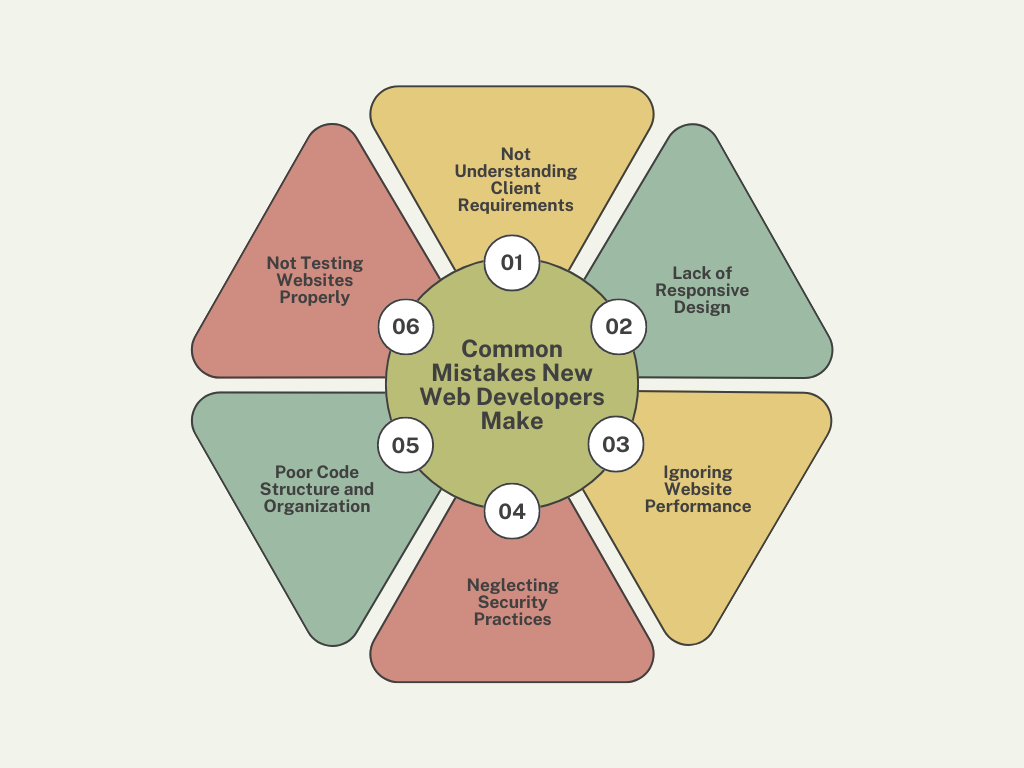A well-designed website is often the first interaction customers have with a company, which makes web development services crucial for businesses. Many new developers, eager to start their career, often rush into building websites without fully understanding the complexities involved. Mistakes are part of the learning process, but understanding common pitfalls can help developers avoid them and provide better results for their clients.
The Importance of a Strong Foundation
Web development is more than just writing code. It involves understanding user needs, design principles, and technical aspects like performance and security. A strong foundation in web development ensures that websites not only look good but also function smoothly. Whether you’re working for a website development company or freelancing, avoiding common mistakes is key to building successful websites for clients.

Common Mistakes New Web Developers Make
Not Understanding Client Requirements
One of the biggest mistakes new developers make is not fully understanding what the client needs. Jumping into development without a clear roadmap can lead to frustration for both the developer and the client. This can result in reworking designs, missing key features, or even delivering a project that doesn’t meet expectations.
Lack of Responsive Design
Many new developers focus only on desktop versions, ignoring how their websites appear on mobile devices. This leads to poor user experience and a higher bounce rate, as more users now browse websites using smartphones and tablets.
Ignoring Website Performance
Another common mistake is neglecting the performance of the website. Slow loading times can drive users away, especially when websites are filled with large images or heavy scripts. Users expect fast-loading websites, and developers need to optimize for speed to keep visitors engaged.
Neglecting Security Practices
Security is often overlooked by new developers. Failure to implement security best practices can make websites vulnerable to hacking, data breaches, and other threats. Ignoring security could lead to serious problems for both the developer and the client.
Poor Code Structure and Organization
Writing clean, well-organized code is essential for any web developer. However, new developers sometimes write messy code that’s hard to maintain or scale. Poor code structure not only makes it difficult to update websites later but also creates problems when working in a team.
Not Testing Websites Properly
Many new developers skip thorough testing, either due to time constraints or a lack of understanding. Failing to test websites properly can result in broken links, buggy features, and poor user experience. Proper testing ensures that the website works across different devices and browsers.
How to Avoid These Mistakes
Clear Communication with Clients
To avoid misunderstandings, it’s important to communicate clearly with clients from the start. This includes discussing their goals, target audience, and specific features they want on the website. Having a detailed plan before you begin coding helps avoid costly mistakes later on.
Building Mobile-Friendly Websites
Developers should always design websites with mobile users in mind. Tools like CSS Flexbox, Grid, and frameworks such as Bootstrap make it easier to build responsive websites that look great on any device. Testing on different screen sizes during development can save time later.
Optimizing for Speed and Performance
Optimizing images, minimizing the use of heavy JavaScript, and enabling caching can greatly improve website speed. Using tools like Google PageSpeed Insights can help you identify performance issues and fix them before the website goes live.
Implementing Proper Security Measures
Security should be a priority in web development. Use HTTPS, secure database connections, and proper password handling to protect sensitive information. Regularly updating plugins and software can prevent vulnerabilities from being exploited by attackers.
Writing Clean and Structured Code
Writing clean code not only helps you but also benefits other developers who might work on the project later. Stick to consistent naming conventions, break your code into smaller functions, and comment your code where necessary. Version control tools like Git can help you keep track of changes and collaborate with others effectively.
Comprehensive Testing
Testing is an integral part of web development. Make sure to test the website across different browsers (Chrome, Firefox, Safari) and devices (desktop, mobile, tablet). Automated testing tools like Selenium or manual checks can help ensure everything works as expected before the website goes live.
Conclusion
Every new web developer makes mistakes—it’s part of the learning curve. However, by understanding common mistakes and how to avoid them, developers can improve their skills and deliver high-quality web development services. Whether you’re working for a website development company like Digital4Design or building websites on your own, always aim for clear communication, responsive design, optimized performance, strong security, and thorough testing. By focusing on these areas, new developers can create websites that meet client needs and provide a great user experience.





